
 |
The moon, called Luna by the Romans, is our closest celestial neighbor and our only natural satellite. With a diameter of 3476 km (2086 mi), this rocky mass orbits the earth once every 29.5 days. The image to the left shows the stark contrast between the gray, highly cratered lunar surface in the foreground and our blue planet Earth in the distant background. The average orbital separation between these two bodies is 384,400 km (230,640 mi). The moon was first visited by the Soviet spacecraft Luna 2 in 1959. A decade later, on July 20, 1969, it was first visited by humans. The last of these historic visits, by Apollo Mission astronauts, was in December 1972. The lunar surface was extensively mapped by the spacecraft Clementine in 1994, and again by the Lunar Prospector in 1999. |
 The moon contains a ~70-km-thick basaltic
crust that differentiated from a denser, underlying mantle at
least 4.4 billion years ago. The crustal rocks returned by the
Apollo Mission range in age from 4.3 to 3.1 billion years old.
In contrast, the oldest rocks on earth are rarely more than 3
billion years old. The lunar crust is easily discernible into
two primary types of terrains: the older highlands, which
comprise about 83% of the lunar surface (light regions in image), and the younger lunar
maria, which comprise the remaining 17% (dark regions).
The heavily cratered highlands are covered with a layer of regolith,
a mixture of fine dust and fragmented debris generated by meteorite
impacts. Beneath the regolith, two crustal rocks types dominate
the highlands:
The moon contains a ~70-km-thick basaltic
crust that differentiated from a denser, underlying mantle at
least 4.4 billion years ago. The crustal rocks returned by the
Apollo Mission range in age from 4.3 to 3.1 billion years old.
In contrast, the oldest rocks on earth are rarely more than 3
billion years old. The lunar crust is easily discernible into
two primary types of terrains: the older highlands, which
comprise about 83% of the lunar surface (light regions in image), and the younger lunar
maria, which comprise the remaining 17% (dark regions).
The heavily cratered highlands are covered with a layer of regolith,
a mixture of fine dust and fragmented debris generated by meteorite
impacts. Beneath the regolith, two crustal rocks types dominate
the highlands:
|
(1) breccia -- a coherent rock of
broken and welded fragments, and (2) anorthosite -- the most abundant highlands rock; it is a feldspar-rich variety of gabbro (which, in turn, is the coarse-grained, equivalent of basalt) |
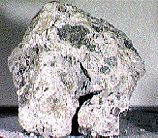
|
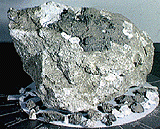
|
|
|
|
Compared with the highlands, the lunar maria (mare, singular) are much darker and have relatively smooth surfaces. The maria are more abundant on the near side of the moon, where they cover about 30% of the lunar surface; on the far side they cover only about 2%. The reason for this is not well understood. Each mare is composed of vast sheets of basaltic lava which erupted from the broken crust associated with large impact craters. There is no evidence to suggest that the impact events triggered the volcanic eruptions. However, the fractures associated with large impact craters may have provided easy egress for younger, mantle-derived melts to rise to the surface. In a sense, these extensive lava fields are the lunar equivalents of terrestrial flood basalt provinces. The maria range in thickness from 1-4 km.
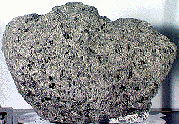
|
Mare Basalt -- This sample of mare basalt, ~3.7 billion years old, was collected by Apollo 17 astronauts. The small holes in the sample are vesicles, which formed by the degassing of the lava as it cooled. Courtesy of NASA. |
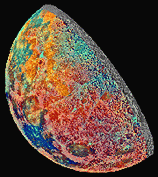 The highlands anorthosite is dominated
by the mineral plagioclase feldspar. The most popular model
for crustal evolution suggests that the anorthosite crystallized
early in the moon's formation from a global magma ocean. Under
this scenario, the lighter plagioclase floated upward to form
an anorthosite crust, and the heavier minerals olivine and pyroxene
sank toward the bottom of the magma ocean to form the moon's upper
mantle. The greatest volume of the highland crust was generated
between 4.5 and 3.9 billion years ago (bya), but it continued
to develop up to ~ 3.2 bya. Episodic melting of the mantle rocks
beneath the highland crust generated the younger mare basalts.
Heavy bombardment of the lunar crust in its early stages of formation
(4.5-3.2 bya) provided fractures for rapid ascent of these mantle
melts and depressions for them to pond in. The greatest volume
of the mare basalts erupted from 3.9 to 3.2 bya, but reduced bombardment
and basaltic volcanism continued until ~2.0 bya. Since ~2.0 bya,
there has been only very minor eruptions, local degassing, and
occasional impacts.
The highlands anorthosite is dominated
by the mineral plagioclase feldspar. The most popular model
for crustal evolution suggests that the anorthosite crystallized
early in the moon's formation from a global magma ocean. Under
this scenario, the lighter plagioclase floated upward to form
an anorthosite crust, and the heavier minerals olivine and pyroxene
sank toward the bottom of the magma ocean to form the moon's upper
mantle. The greatest volume of the highland crust was generated
between 4.5 and 3.9 billion years ago (bya), but it continued
to develop up to ~ 3.2 bya. Episodic melting of the mantle rocks
beneath the highland crust generated the younger mare basalts.
Heavy bombardment of the lunar crust in its early stages of formation
(4.5-3.2 bya) provided fractures for rapid ascent of these mantle
melts and depressions for them to pond in. The greatest volume
of the mare basalts erupted from 3.9 to 3.2 bya, but reduced bombardment
and basaltic volcanism continued until ~2.0 bya. Since ~2.0 bya,
there has been only very minor eruptions, local degassing, and
occasional impacts.
High-resolution photographs of Mare Imbrium reveal spectacular lava flow fronts, extending as much as 1200 km from their source vents. However, these features appear to be unique to Mare Imbrium. Most other mares have smooth surfaces upon which discrete flows cannot be recognized. These are probably composed of compound flows composed of numerous thin flow units.
The mare lava flows are associated with a number of volcanic vents, in the form of domes and scoria cones. The domes are typically found in clusters. They are circular to elliptical, typically a few kilometers across and several hundred meters high. The basaltic domes on the moon appear to be the lunar equivalents of shield volcanoes found on earth. Construction of the relatively steep slopes of the lunar "shields" is poorly understood. Their steep slopes are probably not related to the extrusion of relatively viscous basalt, but rather to the style of extrusion, which may involve eruptions of short duration mixed with minor episodes of ash eruption. The lunar scoria cones are similar in size to terrestrial scoria cones, and they appear to be associated with older fissure systems.
A common and intriguing volcanic landform found in the lunar maria are narrow, winding valleys called sinuous rilles. These range in width from tens of meters to 3 km, and in length from a few kilometers to 300 km. Many originate in irregular craters. One of the largest of these rilles is Hadley Rille in the Imbrium basin, which was visited by Apollo 15 astronauts. Although most workers believe that the sinuous rilles are a combination of lava channels and collapsed lava tubes. However, the mode of lava channel formation remains controversial. Some believe that the channels are "constructional" due to the build up of lava levees along the sides of the channel. However, the majority of the sinuous rilles are thought to the product of thermal erosion of the mare surface by exceptionally hot, fluid lava, similar in composition to the ancient eruptions of komatiite on the Earth's surface billions of years ago.
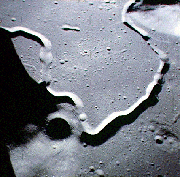
|
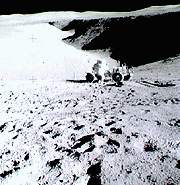
|
|
of Hadley Rille |
Apollo 15 Astronauts |
 Dr. Eugene Shoemaker was
among the world's leaders in the study lunar and planetary geology.
He established the Branch of Astrogeology with the U.S. Geological
Survey, he helped train the Apollo Astronauts, and he was head
of the scientific team to map the moon's surface during Project
Clementine in 1994. He helped establish the Sky Watch
program for tracking earth-crossing asteroids and comets. The
program culminated in the discovery (with his wife Carolyn and
David Levy) of the Shoemaker-Levy comet that collided spectacularly
with Jupiter in 1994. In 1992, he received the highest scientific
honor in the U.S., the National Medal of Science. Tragically,
Dr. Shoemaker died in a car accident in 1997. He had always said
that his greatest unfulfilled dream was to go to the moon. As
a tribute to this great man, his ashes were carried to the moon
during the Lunar Prospector Mission in 1998, thus making
Eugene Shoemaker the first human to have his remains buried on
another planetary body.
Dr. Eugene Shoemaker was
among the world's leaders in the study lunar and planetary geology.
He established the Branch of Astrogeology with the U.S. Geological
Survey, he helped train the Apollo Astronauts, and he was head
of the scientific team to map the moon's surface during Project
Clementine in 1994. He helped establish the Sky Watch
program for tracking earth-crossing asteroids and comets. The
program culminated in the discovery (with his wife Carolyn and
David Levy) of the Shoemaker-Levy comet that collided spectacularly
with Jupiter in 1994. In 1992, he received the highest scientific
honor in the U.S., the National Medal of Science. Tragically,
Dr. Shoemaker died in a car accident in 1997. He had always said
that his greatest unfulfilled dream was to go to the moon. As
a tribute to this great man, his ashes were carried to the moon
during the Lunar Prospector Mission in 1998, thus making
Eugene Shoemaker the first human to have his remains buried on
another planetary body.